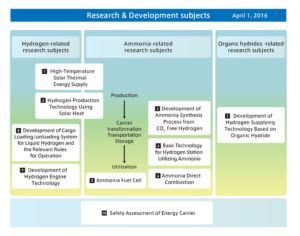Major Development for Ammonia Energy in Japan
By Stephen H. Crolius on August 10, 2017
On July 25, the Japan Science and Technology Agency (JST) announced that a collection of companies and research institutions had come together to form a Green Ammonia Consortium. The 22-member group will take over responsibility for the ammonia aspect of the Cross-Ministerial Strategic Innovation Program (SIP) Energy Carriers agenda when the SIP is discontinued at the end of fiscal 2018. A JST press release states that the Consortium intends to develop a strategy for “forming [an] ammonia value chain,” promote demonstration projects that can further commercialization, and enable “Japanese industry to lead the world market.”

The Chairman of the Consortium will be Shigeru Muraki. Muraki is Executive Advisor to Tokyo Gas Company and currently serves as the Director of the SIP. In the latter capacity, he has responsibility for all ten areas of Energy Carrier research, including those related to liquid hydrogen and organic hydrides such as methyl cyclohexane (MCH).
Three of the Consortium’s 22 members are public research institutions, including the National Institute of Advanced Industrial Science and Technology (AIST); the National Research and Development Corporation’s Marine, Harbor and Aeronautical Research Institute; and the National Institute of Electric Power Industry. AIST is a participant in a number of on-going ammonia energy research efforts. For example, Ammonia Energy reported in February on work being done on ammonia-fueled gas turbines by a team that includes scientists from AIST. The Marine, Harbor and Aeronautical Research Institute has a role in a demonstration of a small fuel-cell powered ship in Hiroshima Prefecture, as reported in a Smart Japan story in March 2017 (and mentioned in a subsequent Ammonia Energy item).
The Consortium’s 19 corporate members are all industrial heavyweights with obvious reasons to be interested in development of ammonia energy. Three of them are engineering-procurement-construction (EPC) firms, five are energy utilities, and the rest are manufacturers of machinery, chemicals, or vehicles.
Several of the companies have visible track records in the field of ammonia energy. For example, chemical manufacturer Nippon Shokubai, ceramics manufacturer Noritake Company, Mitsui Chemical (part of trading company Mitsui & Co.), and Toyota Industries are all collaborating with Kyoto University in the development of ammonia-fueled solid oxide fuel cell technology. (Koichi Eguchi of Kyoto University described the group’s work in this area at the 2016 NH3 Fuel Conference.) Toyota Industries is also collaborating with Hiroshima University on ammonia cracking technology aimed at hydrogen fueling stations, an effort which industrial gas producer Taiyo Nippon Sanso is also supporting. (This work was described in an Ammonia Energy story in February 2017.)
Taiyo Nippon Sanso was featured in a June 26 JST press release on the use of ammonia in industrial furnaces. A team that includes the company, Osaka University, and Nisshin Steel has developed a system for ammonia-methane co-firing in a degreasing furnace that is used to prepare steel sheet for the fabrication of appliances and motor vehicles. The partners believe the technology will be adaptable to most types of industrial burners and will ultimately be able to operate using 100% ammonia. The press release states that industrial burners account for ten percent of Japan’s greenhouse gas emissions.
Diversified manufacturer IHI is collaborating with Tohoku University in the development of ammonia-fired gas turbine technology. (Shintaro Ito of IHI described the group’s work at the 2016 NH3 Fuel Conference.) It was also reported in a Nikkei Asian Review story in March (which became the subject of an Ammonia Energy item the same month) that IHI will demonstrate co-firing of ammonia and methane at its research and development site in Yokohama. The story states that “IHI plans to spend around ¥1 billion [$9.1 million) this year to set up a gas turbine, ammonia tank and other equipment” and that “trial operations are scheduled to begin in the fiscal year starting April 2018.” The co-firing rate will be one part ammonia to five parts methane.
Another member of the Consortium, Chugoku Electric Power Company, was featured in a June 29 JST press release regarding investigation of ammonia co-firing with coal at one of its thermal generating stations. The test will be conducted over a seven-day period and will involve an “ammonia co-firing rate of 0.6%.” (An “immediate goal” of 20% is also mentioned in the press release.) JST will pay the ¥41 million ($373,000) cost of installing and removing the associated temporary piping.
The Green Ammonia Consortium has not announced a timeline for initiation of the group’s activities.
